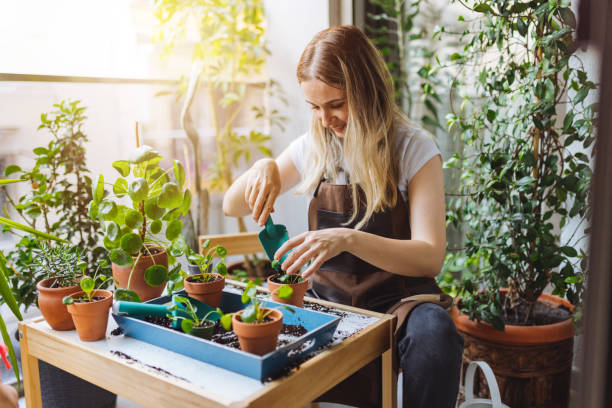Transplanting is an important step in your journey of growing plants, especially for beginners. It involves moving a plant from one container into another and can be a bit intimidating at first. However, with the right knowledge and techniques, it can actually benefit your plants in many ways.
In this article, we’ll explore:
- You will learn why it is essential for plant growth and how it can positively affect your plants’ development.
- We’ll explore the step-by-step techniques to successfully transplant your plants, including the preparation of new pots and the care for plants post-transplantation.
- We will delve into the most frequent errors beginners make and practical tips on how to sidestep these pitfalls for healthier plants.
What is Transplanting?
This process is the act of moving a plant from one container or location to another. It is usually done when a plant has outgrown its current container or needs better-growing conditions. It can also be used as a way to correct any issues with the plant’s roots, such as root-bound plants.
Why It is Important?
It plays a crucial role in a plant’s growth and overall health. Here are some of the reasons why it is important:
- Adequate Space for Growth: As plants grow, they need more space for their roots to spread out and access nutrients. Transplanting into a larger container allows for this growth and prevents the plant from becoming root-bound.
- Better Drainage and Aeration: Plants need proper drainage and oxygen to thrive. Transplanting into well-draining soil or a pot with drainage holes can improve the plant’s overall health.
- Fresh Nutrients: Over time, the nutrients in the soil can become depleted. Transplanting into fresh soil or adding fertilizer to a new potting mix can provide a fresh source of nutrients for the plant.
- Correcting Root Issues: Sometimes, plants can develop root problems such as circling roots or root rot. It allows you to correct these issues and promote healthy root growth.
- Low Stress Training: It can be used as a form of low stress training, which involves manipulating the plant’s growth to increase yields and improve overall health. We will discuss this in more detail later in the article.
Step-by-Step Guide
Step 1: Choose the Right Time to Transplant
It can be stressful for plants, so it’s important to choose the right time to do it. Generally, it is best to transplant when the plant is in its vegetative stage and has not yet started flowering. This allows the plant to focus on establishing roots rather than producing buds.
Step 2: Prepare the New Container and Soil
Choose a new container that is one to two sizes bigger than the current one. Make sure it has good drainage holes and is clean. Fill the bottom of the pot with soil, leaving enough space for the plant’s roots.
The type of soil you use is also important. For most plants, a well-draining potting mix is recommended. However, if you are doing it with succulents or cacti, you may need to use a specific type of soil.
Step 3: Water the Plant
Water your plant thoroughly before the process. This will make it easier to remove the plant from its current container and reduce stress on the roots.
Step 4: Gently Remove the Plant from its Current Container
Carefully turn the plant upside down and gently tap or squeeze the sides of the container to loosen the soil. Avoid pulling on the stem, as this can damage the plant. If necessary, you can use a knife or scissors to loosen any tangled roots.
Step 5: Place the Plant in its New Container
Place the plant in the new container and fill it with soil, gently firming it around the plant. Make sure to leave some space between the top of the soil and the rim of the pot for watering.
Step 6: Water Thoroughly
After the process, water your plant thoroughly to help settle the soil. This will also provide moisture for the roots while they adjust to their new environment.
Congratulations, you have successfully transplanted your plant! Now, let’s discuss some tips to ensure a successful start for your newly transplanted plants.
Tips for a Successful Transplant
- Avoid transplant shock: It can be stressful for plants, so it’s important to minimize any shock by following the steps above and handling the plant gently. You can also add a solution or a root stimulator to the water to help promote healthy root growth.
- Transplant during the plant’s dormant period: If possible, transplant during the plant’s dormant period when it is not actively growing. This will reduce stress on the plant and allow it to focus on establishing roots.
- Use low stress training techniques: As mentioned earlier, it can be used as a form of low stress training. This involves manipulating the plant’s growth to maximize yields and improve overall health. Some techniques include topping, pruning, and bending branches.
- Defoliate auto flowers with caution: Auto flowering plants have a set life cycle and do not rely on light cycles to flower. While defoliation can be beneficial for photoperiod plants, it should be done with caution for auto flowers as they have a limited amount of time to recover from stress.
- Monitor and adjust watering: After the process, the plant’s root system may need time to adjust and may not be able to absorb water as efficiently. Monitor your plant closely and adjust your watering schedule as needed to prevent overwatering or underwatering.
- Provide proper lighting: If doing in outdoors, make sure the plant is receiving the correct amount of sunlight for its specific needs. For indoor plants, adjust the height and intensity of grow lights to prevent stress on the plant.
- Consider using a humidity dome: A humidity dome can help keep the air around the plant moist, reducing stress and encouraging root growth.
Conclusion
The process plays an important role in a plant’s growth and overall health. By providing better drainage and aeration, fresh nutrients, correcting root issues, and using it as a form of low stress training, it can improve yields and promote healthy growth. By following our step-by-step guide and tips, you can confidently transplant your plants and set them up for success. Happy growing!

